

Digital Literacy vs. Digital Fluency. Update 6/13/2012: We finally finished our book on this topic.
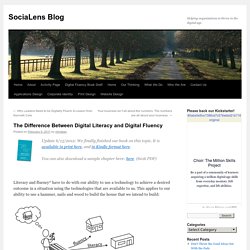
It is available in print here, and in Kindle format here. You can also download a sample chapter here: here (601k PDF) Literacy and fluency* have to do with our ability to use a technology to achieve a desired outcome in a situation using the technologies that are available to us. This applies to our ability to use a hammer, nails and wood to build the house that we intend to build: ..and it applies to our ability to use digital technologies to have the intended positive effect on people and situations: Note that a literate person is perfectly capable of using the tools.
What Is Digital Literacy? Ava reads at Indian Run Elementary School in Dublin, Ohio.

The school integrates iPads, laptops, and books into reading time. —Maddie McGarvey for Education Week Digital Literacy: An Evolving Definition While the word "literacy" alone generally refers to reading and writing skills, when you tack on the word "digital" before it, the term encompasses much, much more. Sure, reading and writing are still very much at the heart of digital literacy. The term is so broad that some experts even stay away from it, preferring to speak more specifically about particular skills at the intersection of technology and literacy.
What Is Digital Fluency? Dreyfus model of skill acquisition - Wikipedia. In the fields of education and operations research, the Dreyfus model of skill acquisition is a model of how students acquire skills through formal instruction and practicing.
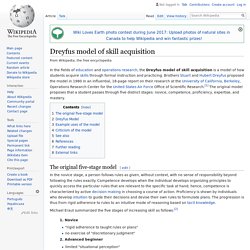
Brothers Stuart and Hubert Dreyfus proposed the model in 1980 in an influential, 18-page report on their research at the University of California, Berkeley, Operations Research Center for the United States Air Force Office of Scientific Research.[1] The original model proposes that a student passes through five distinct stages: novice, competence, proficiency, expertise, and mastery.
The original five-stage model[edit] Michael Eraut summarized the five stages of increasing skill as follows:[2] Dreyfus Model[edit] Instead the original Dreyfus model is based on four binary qualities: Recollection (non-situational or situational)Recognition (decomposed or holistic)Decision (analytical or intuitive)Awareness (monitoring or absorbed) This leads to five roles: Example uses of the model[edit] Criticism of the model[edit]
Four stages of competence - Wikipedia. In psychology, the four stages of competence, or the "conscious competence" learning model, relates to the psychological states involved in the process of progressing from incompetence to competence in a skill.

History[edit] The Essential Elements of Digital Literacies. Beyond Elegant Consumption. At the Mozilla Festival last year, Mozilla Chairperson Mitchell Baker stood up and gave a short talk.

Something she said really resonated with me. In fact, it resonated so much that I baked it right in as a central message of my TEDx Warwick talk. We need to move beyond mere ‘elegant consumption’. There’s nothing inherently wrong with elegant consumption in and of itself. Reading, watching and experiencing other people’s creations put together in a thoughtful and delightful way is joyful.
I’ve championed Apple’s hardware and software since buying my first MacBook in 2006. So why this week did I install Pinguy OS (a Linux distribution) on my iMac and trade my iPhone for the open-source Nokia N9? Until last year, it was possible to swap out almost any hardware and software and still have a functioning ecosystem. Yes, it’s nice that Apple, through iCloud, auto-syncs all of my stuff everywhere.
What is Intrinsic Motivation? Intrinsic motivation refers to behavior that is driven by internal rewards.
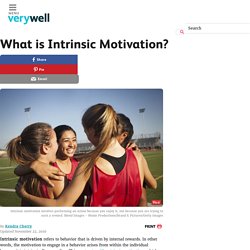
In other words, the motivation to engage in a behavior arises from within the individual because it is intrinsically rewarding. This contrasts with extrinsic motivation, which involves engaging in a behavior in order to earn external rewards or avoid punishments. Consider for a moment your motivation for reading this article. If you are reading it because you have an interest in psychology and simply want to know more about the topic of motivation, then you are acting based upon intrinsic motivation. If, however, you are reading this because you have to learn the information for a class so you can avoid getting a bad grade, then you are acting based upon extrinsic motivation. When was the last time you did something just for the enjoyment of the activity itself?
When you pursue an activity simply for enjoyment, you are doing so doing so because you are intrinsically motivated. Less shiny. Dan Meyer, an inspirational teacher I’ve mentioned plenty of times before, has as his mantra “less helpful”.
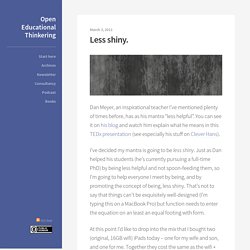
You can see it on his blog and watch him explain what he means in this TEDx presentation (see especially his stuff on Clever Hans). I’ve decided my mantra is going to be less shiny. Just as Dan helped his students (he’s currently pursuing a full-time PhD) by being less helpful and not spoon-feeding them, so I’m going to help everyone I meet by being, and by promoting the concept of being, less shiny. That’s not to say that things can’t be exquisitely well-designed (I’m typing this on a MacBook Pro) but function needs to enter the equation on an least an equal footing with form. Utopia, pedagogy, and G-Suite for Education. This week, I’ve been over in Jersey helping a school with their educational technology.
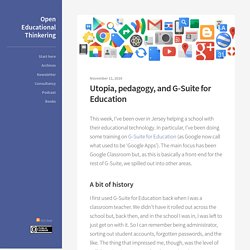
In particular, I’ve been doing some training on G-Suite for Education (as Google now call what used to be ‘Google Apps’). The main focus has been Google Classroom but, as this is basically a front-end for the rest of G-Suite, we spilled out into other areas. Information Literacy as a Way of Life.